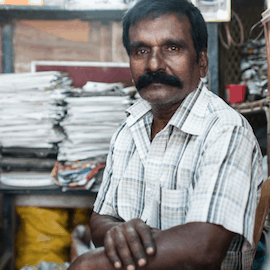From Problem to Profit: Rewiring the E-Waste Value Chain in Africa
Africa is home to bountiful reserves of metals and minerals such as gold, diamond, cobalt, bauxite, iron ore, coal and copper. But these reserves have often been associated with a resource curse, and hence have not unleashed the desired economic transformation.
However, an “urban mine” is quietly growing in the hands of the region’s emerging digital population, in the form of electronic devices, such as mobile phones and laptops, that are loaded with remarkable amounts of precious metals.
Unfortunately, these devices often end up in overflowing landfills at their end-of-life – left for scrap workers who gather them from these toxic environments. But trailblazing trash entrepreneurs on the African continent are increasingly aware that these landfills are, quite literally, gold mines – and they are turning this growing problem into profit by rewiring the broken e-waste value chain.
Africa’s Growing E-Waste Problem: A System Error
E-waste (also called waste electrical and electronic equipment or “WEEE” for short) is currently the world’s fastest-growing domestic waste stream, with the Global E-waste Monitor (GEM) estimating that 53.6 million metric tonnes were generated globally in 2019, up 21% in just five years. Though Africa is currently the second-lowest region when it comes to per capita e-waste generation (at 2.5 kg per capita), it’s also the world’s fastest-growing mobile phone market, with sales of phones and other electronic equipment driven by burgeoning consumer spending from its growing middle class. And beyond locally generated e-waste, the continent also receives significant imports of used electronics from more affluent regions like Europe.
Africa’s recycling activities are not keeping pace with this growth. GEM data shows its documented e-waste collection and recycling rates at merely 0.9%, which pales in comparison to other regions, and recycling is predominantly managed by a thriving informal sector of collectors and recyclers, who use rudimentary processes to extract value from this waste. This results in most of the e-waste on the continent ending up at landfills, which have severe negative health and environmental impacts on their surrounding communities. E-waste, when not properly recycled, poses serious health risks like skin diseases and respiratory illnesses. One well-known example can be seen in Agbogbloshie in Ghana, the site of the world’s largest e-waste dump, where not only the 5,000 scrap workers and informal recyclers but also the wider community are facing severe health issues from inhaling fumes from burning waste, and consuming food and water contaminated by the lead, mercury and cadmium it releases.
These problems are primed to get worse. Looking ahead, Africa’s technological leapfrogging coupled with its rapidly growing population with higher disposable income will create exponential growth in the e-waste generated on the continent. As increasing energy access has enabled wider adoption of essential electrical and electronic products (including off-grid solar energy products themselves), the life cycle of these electronics is becoming shorter, as manufacturers work to make products more affordable by using less durable and valuable components. And similarly to other e-waste categories, the proliferation of solar e-waste poses serious costs recovery challenges to the industry – a problem that’s becoming increasingly urgent as first-generation off-grid solar products are reaching their end-of-life.
A Mountain of E-Waste Opportunity: Closing the Loop
However, the mountains of e-waste in landfills also represent a valuable opportunity, as the precious metals in these discarded products can be recycled as secondary materials. In Africa alone, the GEM estimated the value of e-waste raw materials at US $3.2 billion in 2019. Recycling these used materials through urban mining is economically and environmentally more feasible than extracting natural resources from the ground. It requires a lot less energy, and thus has huge potential to address the global scarcity of natural resources, while also offering immense commercial opportunity. This is especially true in African countries, where most second-hand or scrap metals today are exported for further refining. With the right collection and processing infrastructure, such commercial activities could remain on the continent and create growth for the local e-waste sector.
But extracting raw materials from e-waste isn’t the only path to commercial opportunity. Unlike other waste streams, e-waste is generally not seen as “garbage,” but as goods that can be repaired or reused. This is good news for entrepreneurs hoping to unleash the potential of the circular economy as Africa’s next leapfrog industry, as discussed earlier in this article series. Yet consumers’ awareness of this value has also led many to hold onto their end-of-life electronics as if they were trophies. So how do we close the loop on e-waste? While consumer education is an important way to ensure that electronics owners dispose of, repair or recycle their waste responsibly, product design – e.g., making batteries easier to access and replace – and the availability of spare parts are also important factors in encouraging product life-span extension.
Sharing the Responsibility for E-Waste Management
However, even if efforts to extend electronic products’ life cycle are successful, most will eventually be discarded – and when that happens, someone needs to take responsibility for what comes next. To that end, e-waste policies on the continent are increasingly introducing extended producer responsibility (EPR), which makes the producers of electronic devices responsible for the take-back, recycling and final disposal of the electronics. In 2019, a majority of the 13 African countries that have adopted e-waste policies and regulations incorporated EPR schemes in one form or another. Such policies are intended to encourage producers to design recyclable products, and to help align the ecosystem towards a circular economy by ensuring reverse logistics.
But while these e-waste policies are gaining ground, their implementation is still in its infancy, and the lack of synchronisation between the formal and informal sector is creating market inefficiencies. According to Federico Magalini, Managing Director at Sofies U.K., a project management and consultancy firm working with e-waste, “The informal recyclers use more rudimentary techniques and do not incur the same technical costs as the formal recyclers incur to comply with e-waste management policies. This includes costs related to treatment, de-pollution and proper disposal of hazardous and non-hazardous fractions, as well as the proof of legal compliance, quality and service level. This creates a race to the bottom in terms of responsible e-waste management.” Today the informal e-waste value-chain is only economically viable because the scrap workers and the environment are paying the high price of unsafe collection, dismantling and refurbishing. So how does one create a level and responsible playing field?
How Trash Trailblazers are Rewiring a Broken Value Chain
Going forward, fostering collaborations between the informal and formal sector is critical to closing the loopholes of safe e-waste management. The Solving the E-waste Problem initiative, an e-waste thought leader, recognises that such partnerships should be tailored to the local conditions and reflect the diverse value chain structures in different countries. For example, while safely dismantling some types of hazardous e-waste requires some level of professionalisation, the collection of this waste could be organised through informal waste collector cooperatives, which have the expertise to identify different components of waste and can work in areas with low levels of waste collection infrastructure.
Another pioneering e-waste organisation is the WEEE Centre in Kenya, which has worked since 2012 to rewire e-waste management practices and coordinate the ecosystem in East Africa (and beyond) through over 100 partnerships with businesses and institutions. According to Boniface Mbithi, CEO of the WEEE Centre, “The whole ecosystem while adopting circularity, right from the equipment designers, manufacturers, consumers and recycling companies to organisations that utilise secondary materials for new product creation, all have to collaborate to solve the challenge at scale.” Deploying an asset-based community approach to ensuring impact on the ground, the WEEE Centre today works with over 600 waste workers from the slums of Dandora and Kibera, all of whom are trained in safe e-waste handling.
Another model of collaboration is the producer responsibility organisation (PRO), in which external organisations are authorised or financed by producers to handle e-waste management on their behalf as a response to EPR policies. While only a handful of such PROs currently exist on the African continent, this might prove to be a successful model for ensuring e-waste circularity based on the Indian success story, Karo Sambhav. Karo Sambhav is a PRO that has worked with leading brands like Apple, Dell, HP and Lenovo to implement their extended producer responsibility schemes. As CEO Pranshu Singhal puts it, the organisation uses an “innovative and data-backed tech platform, that along with a country-wide grassroot-driven ecosystem connects all the stakeholders into an integrated, formalised e-waste management chain – where transparency on e-waste flows creates equitable opportunity and fair value for all stakeholders in the value chain.” With a model fit for this purpose, Karo Sambhav is now looking towards the African continent, where it plans to provide its tech platform to like-minded e-waste companies.
These trailblazers show how experimenting with innovative and inclusive business models for managing electronic waste effectively can help rewire the e-waste value chain, creating thousands of decent jobs with safer working conditions and caring for our natural resources. With access to finance and the right policy push these approaches could be scaled up, helping them to turn e-waste from problem to profit in countries across Africa.
Note: This is the third article in a short series focused on the waste-to-value and circular economy from the BESTSELLER Foundation, which is committed to supporting the development of a circular economy ecosystem in sub-Saharan Africa by investing in trailblazers directly, and also by creating partnerships that drive more capital towards the sector. You can view the first article here, and the second one here.
Anne Cathrine Garde is an Investment Manager, and Blessing Layee-Maima Caine is an Investment Assistant at the BESTSELLER Foundation.
Photo courtesy of Rwanda Green Fund.
- Categories
- Technology, WASH



